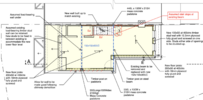- Joined
- 15 May 2023
- Messages
- 43
- Reaction score
- 0
- Country

I'm currently working on my dormer loft conversion, doing it diy so bear with if any of the questions are a bit obvious!
I have plans through from the engineer but there isn't too much on the actual frame. I've attached the drawings - as part of this we have had to lower the FF ceiling, which is around 30cm lower now. Currently we have gotten the two steels in for the floor and all the new joists. We'll be taking the rear of the roof off shortly to frame it out, but i'm getting a little confused by a few of the details:
1. The loft had been converted many years ago (previous owner), with dwarf walls added to replace the purlins (pic attached). The SE said this is fine to replace like for like, down to the new lowered floor joists, but i'm not sure this is the best thing to do. It would mean a bottom plate directly onto the joists, then uprights screwed into each rafter. Is this acceptable or should it be constructed differently?
2. On the rear section of roof, where the joists change direction, there is no steel specced. I would have assumed the dormer frame therefore needs to sit directly on the existing wall, however it's a solid wall and the eaves are minimal so this almost definitely would not leave the required 200mm from edge of eaves. Is there a simple way around this?
3. The new wall plate at the front of the house (where the pitched roof is remaining) is now lower than the rafters, with original joists being removed. Do the new joists need to be tied back into the rafters, or does the dwarf wall achieve this?
4. I'm looking to get the outside clad in greencoat plx (will get someone to do this though). Does metal cladding typically require 50mm gap (battened and counter battened)?
I have plans through from the engineer but there isn't too much on the actual frame. I've attached the drawings - as part of this we have had to lower the FF ceiling, which is around 30cm lower now. Currently we have gotten the two steels in for the floor and all the new joists. We'll be taking the rear of the roof off shortly to frame it out, but i'm getting a little confused by a few of the details:
1. The loft had been converted many years ago (previous owner), with dwarf walls added to replace the purlins (pic attached). The SE said this is fine to replace like for like, down to the new lowered floor joists, but i'm not sure this is the best thing to do. It would mean a bottom plate directly onto the joists, then uprights screwed into each rafter. Is this acceptable or should it be constructed differently?
2. On the rear section of roof, where the joists change direction, there is no steel specced. I would have assumed the dormer frame therefore needs to sit directly on the existing wall, however it's a solid wall and the eaves are minimal so this almost definitely would not leave the required 200mm from edge of eaves. Is there a simple way around this?
3. The new wall plate at the front of the house (where the pitched roof is remaining) is now lower than the rafters, with original joists being removed. Do the new joists need to be tied back into the rafters, or does the dwarf wall achieve this?
4. I'm looking to get the outside clad in greencoat plx (will get someone to do this though). Does metal cladding typically require 50mm gap (battened and counter battened)?



